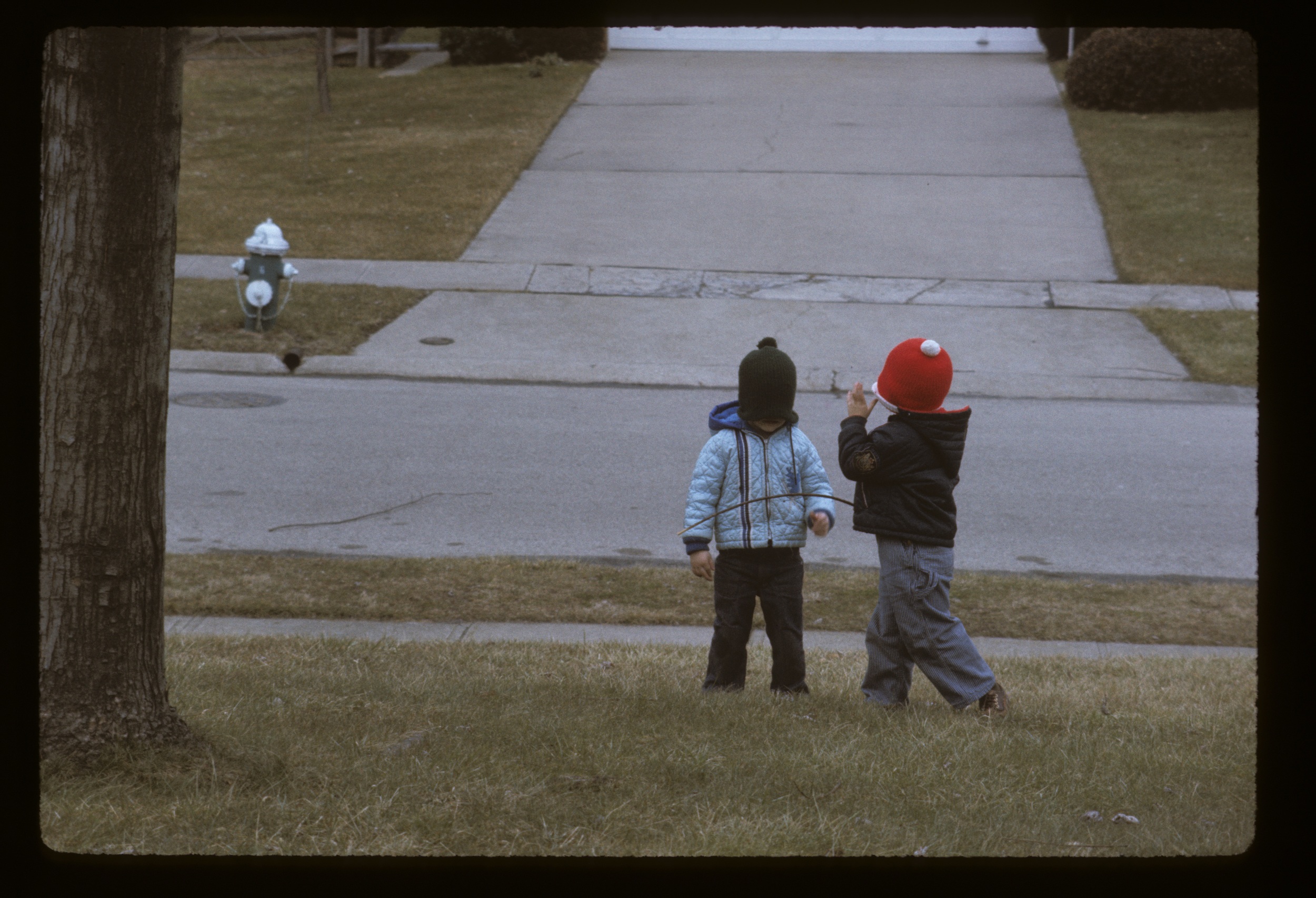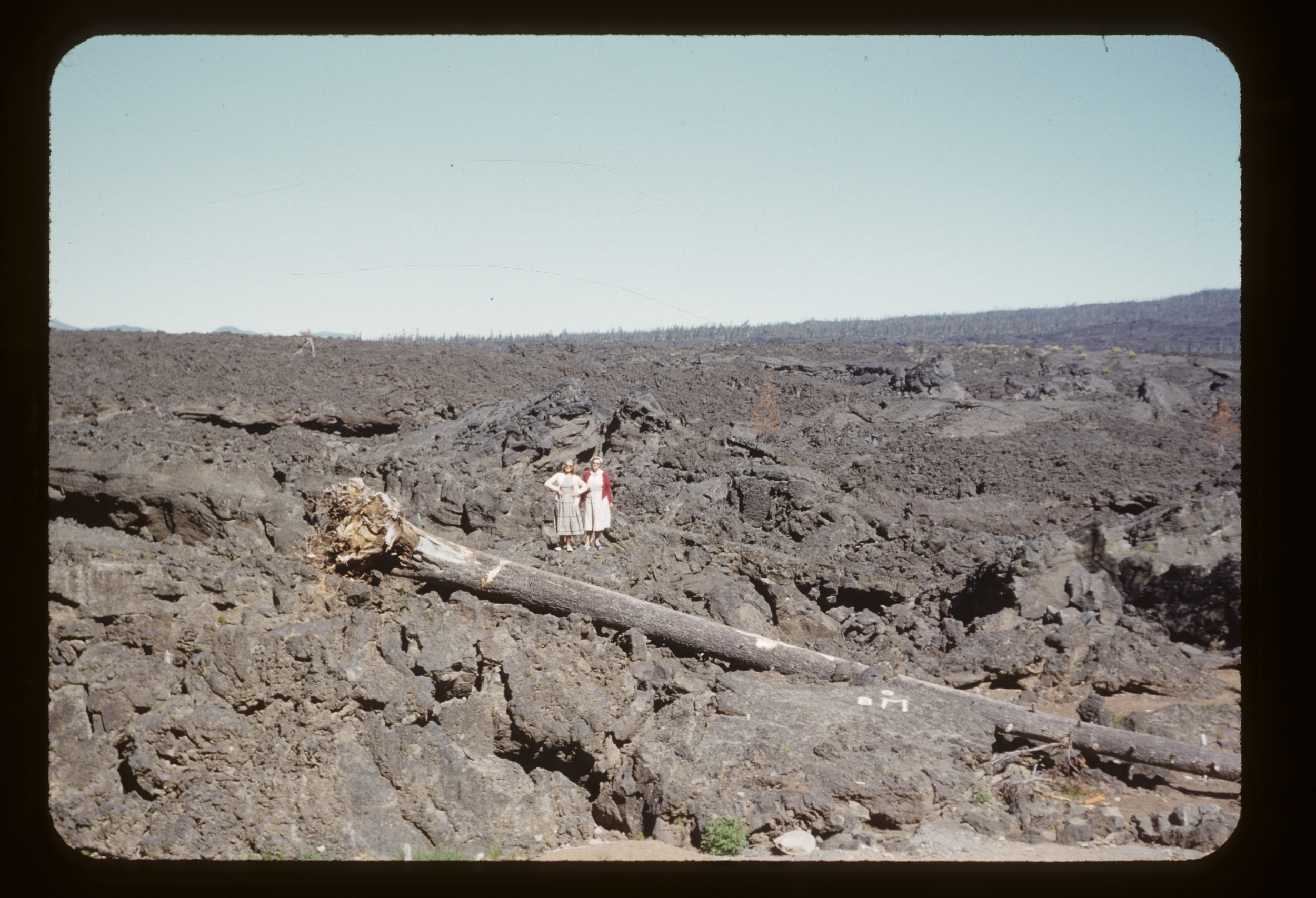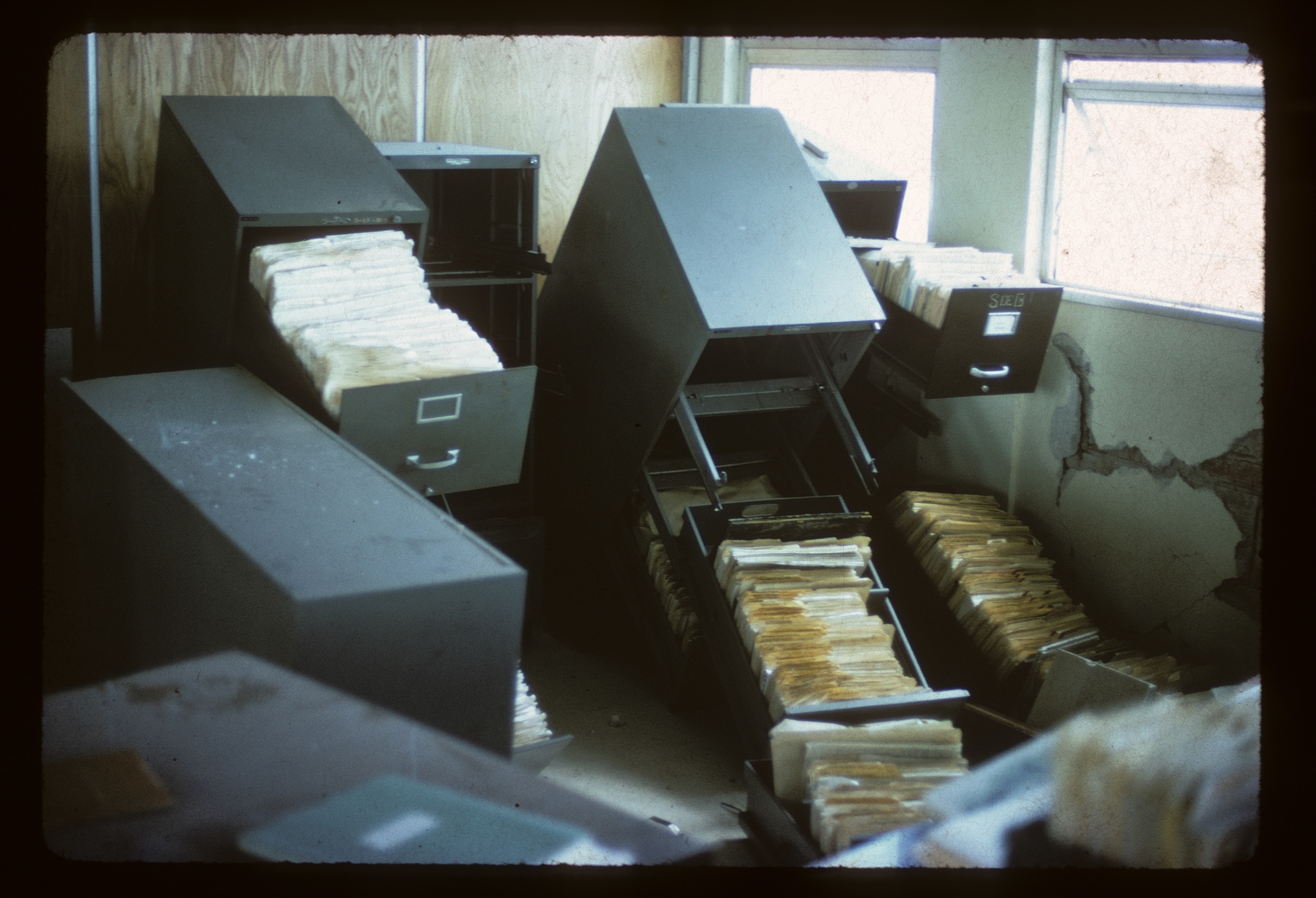This interview originally appeared at The Conversant (September 2015) but the website has disappeared so I’m reposting it here.
I first saw Justin Clifford Rhody’s monthly slideshow Vernacular Visions at Huffin House, a live-in warehouse space in East Oakland. The lights were turned off, and a large crowd of intoxicated partygoers huddled on couches, chairs, and on the carpet as Rhody projected a series of random, unrelated images onto a blank wall. Underneath the hum of the slide projector and a mixtape soundtrack, Rhody provided a tongue-in-cheek voiceover to the slides, something akin to a DVD commentary track but one that welcomed and interacted with the viewer. As I returned each month to see Vernacular Visions at it’s various locations, but most prominently at Lake Merritt in Oakland, I saw that each slide, taken out of its cultural, historical, and personal context, could be seen in a new association. Images that were originally disregarded as having no value suddenly had opportunities to be re-interpreted, and re-valued, often on artistic grounds. It’s what the surrealists might refer to as poetry made by all. Earlier this year, I sat down with Rhody at his East Oakland apartment for a question and answer session about Vernacular Visions and the ideas behind the project.
B: Where did you live before the Bay Area?
J: I was born and raised in Flint, Michigan. I grew up there, but then after high school I’ve just kind of lived in a lot of different places: Indiana, North Carolina, Maine, Seattle for two months.
B: Have you always been interested in photography?
J: No, music was my major focus before. I always played in bands and for thirteen years I ran a record label called Friends & Relatives. 2006 was when I became more serious about photography, as in doing it all the time, and less randomly.
B: Do you have a formal art background? Are you self-taught?
J: I don’t have any background. I didn’t go to school at all. I got out of high school early and really hated it. But, as I’m saying this, coincidentally, I started going to college this year for the first time. I’m thirty.
B: What are you studying?
J: Photography. I don’t know if school will be my favorite thing, and I don’t know how much I’ll get out of it, but it’s better than working for a living. And I get some grant because I’m older. I have access to all of these resources, and it’s been fun. It’s much more relaxing than customer service. I don’t think that the good Lord designed me to a help people along in their purchases [laughs].
B: It’s strange hearing that you’re going back to school, because you’re already a respected photographer. Do you notices a difference between how you approach photography and how other students approach photography?
J: Most people are concerned with making a living, especially at the community college level. You get people from a different spectrum than if it was at the Art Institute. People are interested in commercial interests, and they just don’t believe you if you’re like, “I don’t want to do that.” I couldn’t imagine going and photographing weddings, or like, babies [laughs].
B: How would you describe Vernacular Visions?
J: I would say it’s a slideshow of found 35mm photo slides, which happens monthly in the East Bay, mostly. It’s comprised of photo slides that I gather by the thousands from flea markets, and junk stores, and I then edit together an entertaining, or at least interesting, show. I make a unique soundtrack from records for each show, and it’s been a big hit. And every other month there is a guest presenter, usually a photographer or a filmmaker.
B: How did you first get interested in found slides?
J: I always enjoyed collecting found photos. When I was in high school I remember I used to collect them from the dumpster behind a photo lab. But at flea markets here in the Bay Area I had been coming across these slides, and originally I had been doing slideshows of my own photos and traveling with that. So, it was fun just to buy them, and at home go through them. We don’t have a television, so showing slides was kind of like our entertainment. That’s all we’d do all night. Then we just started keeping the best of, and when people would come over that’s what we’d show them for fun. People seemed to like it a lot. Initially, it was going to be a one-off thing, and then it just snowballed into something much larger.
B: You get your slides primarily from flea markets?
J: Yeah, and junk stores. I’ve never bought them online. I wonder when the supply is going to run dry?
B: What makes a slide worth being shown?
J: That’s the part that’s the most fun, organizing it. Because initially it was more or less just a visual exercise, like looking through them, thinking about why this photograph works, and why this photograph doesn’t work. Sometimes you can witness the photographer’s intention, like if they used a point-and-shoot camera with the viewfinder slightly off. They’re just an inch off of what they thought they were photographing. A pole or a hand interjects, and cuts the composition. It’s kind of like the cut-up method of Brion Gysin, and the stuff Burroughs did with audiotape and text. It’s kind of like a photo book, because the sequence of images, what comes before and after, affects the way that they’re each viewed. It’s like a mixtape. Sometimes there are images of iconic landmarks that every tourist photographs, and when you have a bunch of them together it really changes the meaning of the individual images.
B: Is there a reason why you chose 35mm slides as opposed to just curating found photos?
J: Largely, it’s a spatial issue. I do have boxes of found print photos, but to display them I’d have to have the physical space. And it also requires a different amount of time, like all this time being in a gallery space.
It’s also fun the way that slides are just naturally set up for projection, and blend themselves easily to video projection. You know, it’s a show, it’s a slideshow. I’m doing it in this public way without the context of who took the photos, but the people who took the photos showed them in a similar way, just to their bored family members instead.
B: I always thought of it like, you can find photographs anywhere, but with slides people took an extra step to make an image a slide. There is something more unique about them.
J: Like all the Kodachrome slides. These were made from topnotch color film that was supposed to last for at least fifty years. Whereas the other color negatives, they would partially fade. So, just that intention, these people seem more serious about it, because they were paying extra for a special type of film.
B: When you’re looking through the slides, can you recognize what photos are domestic versus photos that are made for artistic reasons? Do you make a distinction between these types?
J: I suppose there are different forms of artistic intention. Everyone is trying to make a good photo, but there are some that scream “art school,” and you can see it right away. Maybe I’ll throw a few in for fun, but by and large they feel a little vapid.
B: Some of the photos you show do seem to have an artistic purpose, like maybe this person is trying to do some kind of composition.
J: That’s something that goes through my head a lot. Imagining what the person had intended. But the art stuff is different than the general attitudes that come out of these vernacular photographs. The art stuff is more like, “This is an assignment. I’m photographing this fence with a polarizing filter at 3pm.” But the stuff we are really working with here, these common photos, they share the same aesthetic you see in some of the finest photographer’s work, like Walker Evans. You have to sift through a lot of fat to get to the bone though.
B: How do you feel about people who think that are being wronged or defamed by the showing of this found material?
J: There have been a few times when there have been slides where people are naked. I don’t show the pornographic stuff. There was one that was a side view of a pregnant mother. It’s not erotic. It’s not pornography. But it is a nude, and that’s an issue I can imagine someone might really care about. I try to consider where I’ll be showing the image. If it’s at Lake Merritt to a small crowd of people who are there with photographic, artistic intentions, than I’m less concerned about the work being viewed in a perverse light.
B: Many of the Vernacular Visions are held in DIY spaces (Black Hole Cinematheque, the basement of Vacation, Huffin House), but most of them are at Lake Merritt. What’s the appeal of using a public space to show these slides?
J: I would like more things to be happening in these public spheres. I live near Lake Merritt, and it’s really beautiful. In Oakland there are a lot of street corners and parking lots you might not want to set up your stuff at and start doing a show. There are some rougher areas. But Lake Merritt is really beautiful. I saw there was an electrical outlet, brought something to test it out, and it had power. It’s also a centralized location, so people can come from all over Oakland.
B: What is that structure you set up by, a gazebo?
J: Yeah, a weird gazebo; really tall. We’ve had issues when thinking of where to hold shows, because even though it might be a great space, I want as many different types of people to feel comfortable as possible. The basement of a dirty punk warehouse is like a dungeon. It could be really great, but certain people may not come. And galleries are kind of like the polar opposite of that. Sometimes I imagine that would be so ideal and perfect, except for the general vibe of the place. It’s a little bleached or something. Galleries are generally not a space where creativity is occurring. Instead, it’s the space in which its being documented, stamped, pressed, and showcased.
B: When you’re doing a slideshow, you supplement it with a rather flippant and casual commentary, and you always seem to play a mixtape. How did you come to this approach?
J: I came to that approach because humor and casualness are good tools if you’re uncomfortable and nervous. Before showing found slides, I had begun traveling like a band would on tour, but with a slideshow set up showing my own photos.
And it was also that I don’t really like the experience of performing, especially if I was just going to hold a guitar and sing. The slideshow just seemed like the best option. No one is staring at me. I’m behind the projector. I’m getting to show my photos. I don’t have to work very hard, and it’s still a traveling show, which is fun.
B: Sometimes at Vernacular Visions it almost feels like people are just hanging out. You have the tape going, you’re talking, and I think people feel really comfortable with that.
J: I’ve tried to encourage that. And the thing I often say is that, unlike a movie where you have to follow the storyline, at the slideshows you should feel comfortable to talk out loud. Maybe it’s too much of a Fifties vibe, but I’d love it if there were teenagers in the back making out \[laughs]. I don’t think teenagers come, but that would be wonderful. That would be great!
B: When I was looking at your photography the first thing I asked myself was how your photography related to these found slides. Do you see a connection?
J: Yeah, I think there’s a connection. Not just by organizing the Vernacular Visions series, but even before that as I was just viewing images. I had this veracious appetite for imagery and for photography, and thinking about the still image. It wasn’t particularly easy growing up to find interesting art photography. The type of stuff that I was coming across was more like William Wegman. You know, with the two dogs. He dresses his dogs up \[laughs]. I’m not moved by it.
You know with the found slides, and my own work too, the reason they seem to work is because of that implied narrative. What exists outside of the frame. Not necessarily trying to tell a story, because they can’t, but it’s more exciting for a still image to feel larger, rather than something constructed, where there’s nothing beyond it.
B: At the last Vernacular Visions I attended at Artists’ Television Access, I felt like at times you were juxtaposing things in both cultural and historical ways.
J: It’s intentional. But it’s almost like you’re riding some weird line sometimes. I don’t want the intentionality to be too obvious, as if I’m just trying to illustrate a point. There’s something about vagueness that leaves it open for interpretation. That seems to be one of the strong points, especially with photographic images, because it doesn’t clearly illustrate something. Photography is different from painting or drawing, because in those mediums you begin with nothing, and you make something out of it. In photography you begin with everything, and you’re trying to whittle it into one thing. The cacophony and chaos of the world makes it difficult.
B: By stripping away the identity of the photographer, and the context of the work, is something new being brought to these images? What is it?
J: The anonymity of the image lends itself to a more steadied focus. You have to look and think about it. If the photograph was by a celebrated artist, people often know about the artist’s life more so than they even understand the work. And sometimes that psychoanalyzing is a little unwarranted. For example, some images, taken outside of the context of a “family vacation” being presented to the extended family, and then being put in the environment of these people at Vernacular Visions who aren’t just concerned with base facts, hopefully that encourages more thought from the viewer.
B: And I think that by stripping away the identity of the photographer, people can more easily approach the images as potential works of art, rather than some picture their mother, uncle or some other family member took.
J: When I was younger I was really averse to being spoken of as an artist, because I thought that it inherently implied pretension. And I think photography is the perfect medium for that aversion, because it’s so democratic. In other mediums it often feels like someone has invented their own world, and it’s being presented to me, but photography feels like the opposite of that. We see the world that we share from a different perspective.
B: As a photographer, how do you feel about transforming your role? I mean, with Vernacular Visions you’re basically a curator.
J: I’m comfortable with it. I guess my overall game plan in life is to teach. With an upbringing in punk and DIY culture, I can imagine being an educator in some sort of alternative setting. I try to keep Vernacular Visions kind of loose, but it is presented in this way, and people have spoken about it to me in this sort of manner. You’re not going to a lecture, but it encourages thought, to present something in a way in which people hadn’t previously seen it.
B: I kind of see Vernacular Visions as parallel to the zine you do, Slo-Mo, where you just photocopy found object and odd things, a sort of collecting and documenting process.
J: Well, I love collections. I lived in Bloomington, Indiana for five years, and on the University campus there’s a place called the Lilly Library. They would create exhibits of odd books, tiny Bibles, a lock of Sylvia Plath’s hair, and that place kind of got me thinking about how when I was a kid I was really into collecting stuff. It’s kind of embarrassing, but I had these action figures, and I would just set them up neatly on a shelf more than I would ever play with them. I never hammered them together to act like they were fighting. It was just about collecting. I never followed baseball, but I wanted all the baseball cards, and I’d keep them neat in the sleeves. Part of it is the collecting and searching, but the other key aspect is the presentation and display.
B: Are there any particular slides that stand out for you as personal favorites?
J: The recent program that was screened at Artists’ Television Access was an assemblage of the “greatest hits.” My number one favorite seems to have been taken from the perspective of a woman who has just given birth, and is on her back in the hospital bed. A doctor is handing the baby toward her, toward the camera. The umbilical cord is still there. I would love to see a huge print of that one on a wall.
B: Besides a good time, what should viewers get out of attending a Vernacular Visions?
J: I hope that people will see it as a low stress environment to encourage thought, which I think could range from discussions of socio-political theory to talk of composition and form. That’s what I’d like to imagine is happening, and I think that’s what people have been getting out of it in various ways. No one’s ever complained!



